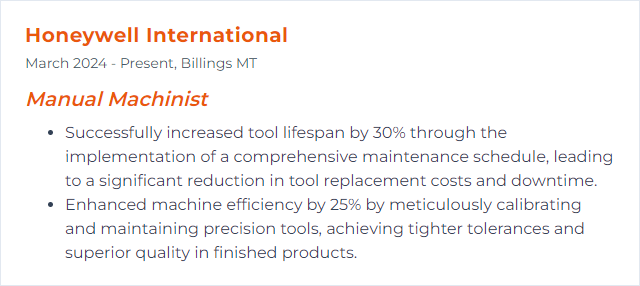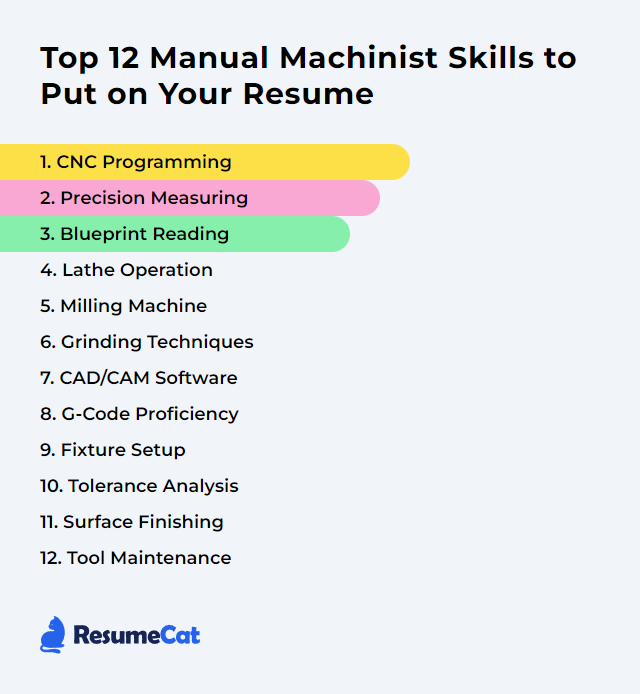Top 12 Manual Machinist Skills to Put on Your Resume
In today's job market, standing out as a manual machinist means showing a sharp blend of hands-on technique and clear-headed problem solving. Your resume needs to convey both—what you can make, how precisely you can make it, and how you adapt when the print changes or the material fights back.
Manual Machinist Skills
- CNC Programming
- Precision Measuring
- Blueprint Reading
- Lathe Operation
- Milling Machine
- Grinding Techniques
- CAD/CAM Software
- G-Code Proficiency
- Fixture Setup
- Tolerance Analysis
- Surface Finishing
- Tool Maintenance
1. CNC Programming
CNC programming means writing instructions that drive automated machines to cut, shape, and finish material with repeatable accuracy. For a manual machinist, it’s a step from feel and handwheel finesse to digital precision and predictable throughput.
Why It's Important
CNC opens the door to complex geometry, tighter repeatability, and faster turnarounds. It amplifies what you can produce and how consistently you can produce it.
How to Improve CNC Programming Skills
Build from the ground up and keep iterating. Focus on fundamentals, toolpath strategy, and safe practice before metal meets spindle.
Learn the basics: Coordinates, work offsets, tool length comp, canned cycles. Know the machine’s limits and quirks.
Master CAD/CAM: Start with an approachable package, learn 2.5D toolpaths first (facing, contouring, pocketing), then step into 3D.
Understand G-code: Read and edit posts, recognize common codes (G00, G01, G02/03, G41/42), and know what safe startup lines should look like.
Use simulators: Prove out programs virtually. Catch collisions, gouges, and rapids gone wrong before pressing cycle start.
Practice on real parts: Start with simple fixtures or soft jaws. Incremental wins build confidence and speed.
Keep learning: Update tool libraries, watch new strategies, and document mistakes alongside fixes.
Steady reps, careful verification, clean code—your programming will tighten up fast.
How to Display CNC Programming Skills on Your Resume
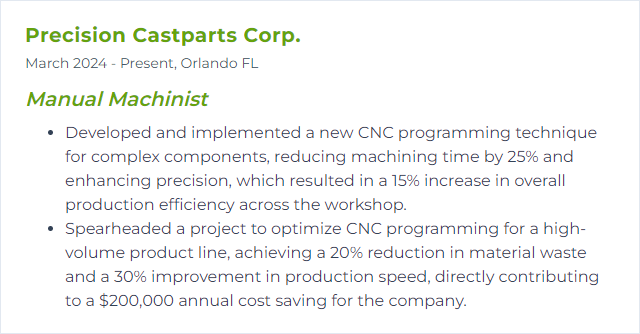
2. Precision Measuring
Precision measuring is the disciplined use of micrometers, calipers, indicators, pins, and gauges to confirm parts meet the print—no guessing, no “close enough.”
Why It's Important
If you can’t measure it, you can’t make it. Accurate measurement protects function, fit, and trust.
How to Improve Precision Measuring Skills
Choose the right tool: Match range and resolution to the tolerance. Digital readouts help, but technique still rules.
Calibrate regularly: Set a schedule. Use standards. Record results. Drift happens—catch it early.
Handle and store with care: Clean, dry, cased. Avoid drops, temperature swings, and shop grit.
Control temperature: Measure in a stable environment, or compensate for thermal expansion. Warm hands can skew readings.
Refine technique: Consistent feel, square alignment, multiple readings. Average out noise, don’t chase one-off numbers.
Train and re-train: Periodic refreshers reduce bad habits and sharpen consistency.
Accuracy is a habit. Build it into every setup and inspection.
How to Display Precision Measuring Skills on Your Resume

3. Blueprint Reading
Blueprint reading means translating 2D drawings into real parts: views, sections, callouts, finishes, and the intent behind the geometry. It’s the map and the compass.
Why It's Important
Misread the print and everything downstream suffers—tooling, time, scrap. Read it right and setups sing.
How to Improve Blueprint Reading Skills
Learn symbols and notes: Materials, finishes, threads, surface callouts, and standard abbreviations. No guesswork.
Orthographic projections: Understand how front, top, side, and section views marry into a single form.
Dimensions and tolerances: Read limit dimensions and fits, and know what the tolerance scheme implies for process capability.
Study GD&T: Datums, position, flatness, parallelism, profile. ASME Y14.5 principles unlock design intent.
Practice often: Work through increasingly complex prints. Recreate parts in your head, then on the machine.
Seek feedback: Compare interpretations with experienced machinists or engineers. Discuss edge cases.
Use reference texts: Keep a reliable handbook nearby for symbols, threads, and format conventions.
With fluency comes fewer surprises and cleaner machining paths.
How to Display Blueprint Reading Skills on Your Resume
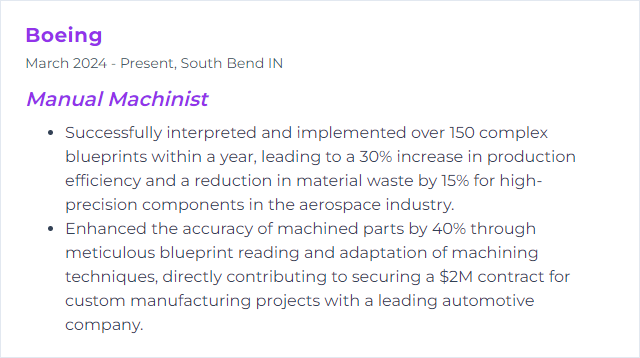
4. Lathe Operation
Lathe operation is controlled rotation plus cutting tool choreography: facing, turning, parting, drilling, boring, threading—bringing round parts into tight spec.
Why It's Important
Lathes produce shafts, bushings, fittings, and every cylindrical feature in between. Precision on a lathe sets the tone for assemblies that just slide together.
How to Improve Lathe Operation Skills
Maintain the machine: Clean and lubricate, check gibs and alignment, keep ways protected. Smooth machines cut smooth parts.
Pick the right tool: Proper insert geometry and a sharp edge curb chatter and lift finishes.
Dial in speed and feed: Match to material and tool. Use charts to get close, then tune by chip color and sound.
Use coolant smartly: Control heat, extend tool life, and keep chips moving.
Build technique: Practice facing flat, holding size on diameters, single-point threading, and boring without taper.
Measure as you go: Mic every critical turn, check runout, and verify shoulders.
Stay safe: No loose sleeves, no jewelry, and keep hands off spinning parts. Respect the chuck.
Good habits compound. So do clean chips and clean cuts.
How to Display Lathe Operation Skills on Your Resume
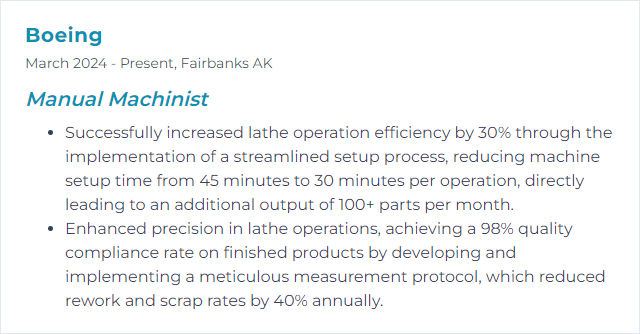
5. Milling Machine
A milling machine rotates a cutter and sculpts the part. Slots, pockets, contours, bores—flat or 3D—precision comes from rigidity, planning, and steady control.
Why It's Important
Mills create complex features and accurate datum surfaces that other operations depend on. They’re the backbone of one-off work and small-batch production.
How to Improve Milling Machine Skills
Upgrade tooling: Use quality carbide end mills and matched holders. Balanced tooling cuts cleaner.
Boost rigidity: Level the machine, reduce stick-out, and use vibration damping when needed.
Improve workholding: Invest in a precise vise, parallels, soft jaws, and solid clamping strategies.
Maintain religiously: Lubricate, clean, tram the head, and inspect leadscrews and spindle for play.
Add a DRO: Digital readouts raise accuracy and speed up repeats.
Refine strategies: Step down with optimal stepovers, use climb milling where appropriate, and manage chip load.
Result: tighter tolerances, sweeter finishes, fewer do-overs.
How to Display Milling Machine Skills on Your Resume

6. Grinding Techniques
Grinding uses abrasive wheels to shape, sharpen, and finish parts to size and to surface requirements that cutting tools alone can’t reach.
Why It's Important
When tolerances get tight and finishes must gleam, grinding steps in. It controls size, geometry, and surface integrity.
How to Improve Grinding Techniques Skills
Know your material: Choose wheel type, grit, grade, and bond to match the workpiece and finish target.
Dress the wheel: Keep it sharp and true. A loaded or glazed wheel burns parts and wanders off-size.
Maintain the grinder: Alignments, spindle condition, and clean slides matter more than you think.
Manage heat: Use the right coolant, flow, and filtration. Heat is the enemy of dimension and temper.
Run correct parameters: Conservative feeds and controlled passes usually win. Let the abrasive do the work.
Protect yourself: Guards on, PPE on, and never stand in line with a wheel during startup.
Keep improving: Log results, tweak variables, and compare finishes under consistent lighting and measurement.
Small refinements here save parts and reputations.
How to Display Grinding Techniques Skills on Your Resume

7. CAD/CAM Software
CAD/CAM tools let you design parts and generate toolpaths digitally, tightening the loop from concept to chips.
Why It's Important
Digital workflows reduce errors, speed up iterations, and unlock complex geometry that’s tough to plan by hand.
How to Improve CAD/CAM Software Skills
Learn the interface: Shortcuts, sketching, constraints, and model history—faster modeling means faster programming.
Set up libraries: Accurate tools, holders, and materials give realistic feeds, speeds, and simulations.
Master core toolpaths: Face, 2D contour, pocket, drilling, adaptive clearing. Then climb to 3D and multiaxis if needed.
Use simulation: Verify stock removal, collisions, and reach. Trust but verify.
Understand posts: Configure post processors and safe start/end blocks for your machine control.
Follow tutorials and projects: Build muscle memory through small, complete parts from start to finish.
Consider cost and access: Choose a tool that fits your shop—subscriptions, perpetual licenses, or capable free options all exist.
The tighter your digital prep, the smoother your first run.
How to Display CAD/CAM Software Skills on Your Resume
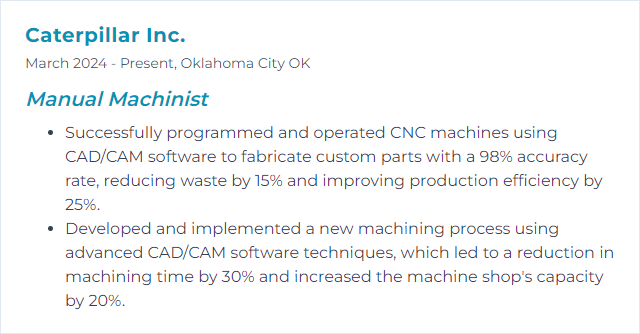
8. G-Code Proficiency
G-code proficiency means you can read, write, and tweak the language that CNC machines obey—feeds, speeds, moves, arcs, comps, tool calls.
Why It's Important
When a program misbehaves, you fix it. When time’s tight, you streamline. Control at this level saves parts and time.
How to Improve G-Code Proficiency Skills
Start with fundamentals: Motion modes, coordinates, plane selection, units, and safe starts.
Write by hand: Short programs for facing, drilling patterns, and basic contours sharpen understanding.
Study examples: Compare posted code to on-screen toolpaths. Spot patterns and conventions.
Simulate first: Visualize tool motion, check tool changes, and validate coolant and spindle commands.
Iterate on real projects: Make controlled edits on the floor—feeds, lead-ins, dwell times—then document what worked.
Stay current: Different controls vary (Fanuc, Haas, Heidenhain, Siemens). Learn the dialect you run.
Confidence grows as your edits get smaller and smarter.
How to Display G-Code Proficiency Skills on Your Resume

9. Fixture Setup
Fixture setup means holding the work securely and precisely so machining can happen without slip, chatter, or surprise movement.
Why It's Important
Good fixturing shrinks cycle time, improves consistency, and protects both tools and parts.
How to Improve Fixture Setup Skills
Standardize where possible: Reusable components and locating features cut setup time and boost repeatability.
Plan ahead: Sketch the setup, choose datums, and verify clearance for tools and clamps.
Use modular systems: Plates, risers, and adjustable elements reduce reinventing every job.
Adopt quick-change: Quick-swap vises, jaws, and plates slash downtime between jobs.
Verify alignment: Check parallelism and squareness with indicators, blocks, and squares before cutting.
Keep it clean: Chips under a part are the enemy of flatness and repeatability.
Document setups: Photos, torque values, offsets, and notes make repeats painless.
Learn continuously: Study new clamping methods and share wins (and misses) with the team.
Rigid, simple, accessible—that’s a winning fixture.
How to Display Fixture Setup Skills on Your Resume

10. Tolerance Analysis
Tolerance analysis examines how part variation stacks up in an assembly so everything fits and functions even when dimensions drift within allowed limits.
Why It's Important
It cuts scrap, avoids rework, and ensures the final product works as designed—no binding, no slop.
How to Improve Tolerance Analysis Skills
Know your tolerances: Dimensional and geometric. Understand what each actually controls on the part.
Measure right: Calibrated tools, correct technique, and consistent conditions.
Account for materials: Watch for growth, stress relief, and deformation during and after machining.
Tighten processes: Sharp tools, proper feeds, and solid setups reduce variation at the source.
Use SPC where helpful: Track key features, analyze trends, and correct before they drift out.
Keep learning: Standards evolve, practices improve. Refresh skills and review past stack-ups.
Predict the variation, plan for it, and your assemblies will just work.
How to Display Tolerance Analysis Skills on Your Resume

11. Surface Finishing
Surface finishing shapes the final look and feel—roughness, sheen, and micro-geometry that affect friction, sealing, and wear.
Why It's Important
Better finishes often mean better performance: smoother motion, less corrosion, tighter sealing, longer life.
How to Improve Surface Finishing Skills
Pick proper tooling: Tool material and geometry should match the stock and the finish target.
Tune cutting parameters: Speed, feed, and depth of cut all influence roughness and consistency.
Choose smart toolpaths: Prefer climb milling where appropriate to reduce deflection and improve finish.
Use the right fluids: Coolants and cutting oils reduce heat, built-up edge, and tearing.
Maintain machines: Alignment, spindle bearings, and tool sharpness have outsized impact on finish.
Apply fine finishing: Hone, lap, polish, or buff when prints demand ultra-smooth surfaces.
Measure and adjust: Check Ra/Rz with appropriate gauges and tweak parameters based on real data.
Chasing a good finish is equal parts setup, tooling, and patience.
How to Display Surface Finishing Skills on Your Resume
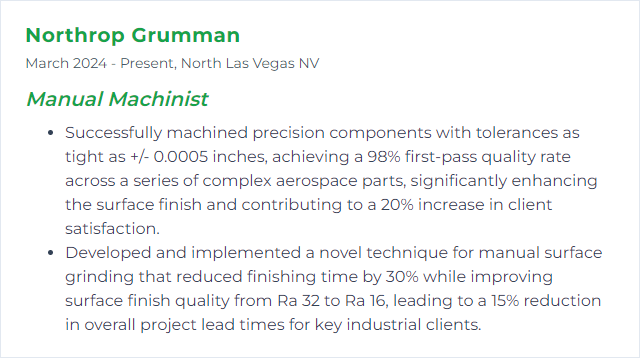
12. Tool Maintenance
Tool maintenance is the quiet work that keeps accuracy alive—cleaning, sharpening, lubricating, inspecting, and storing tools so they perform like new.
Why It's Important
Reliable tools cut true, last longer, and reduce breakage. Safer too.
How to Improve Tool Maintenance Skills
Clean after use: Remove chips and residue, dry thoroughly, and prevent corrosion.
Store properly: Organized, dry, cushioned storage prevents nicks and rust.
Lubricate moving parts: Use correct oils and greases on schedules that match usage.
Keep edges sharp: Dull tools wander and overheat. Sharpen or replace before quality slips.
Inspect routinely: Look for wear, runout, cracks, and handle integrity. Document findings.
Follow maker guidance: Adhere to recommended maintenance intervals and procedures.
Disciplined upkeep pays back in precision and fewer surprises.
How to Display Tool Maintenance Skills on Your Resume
